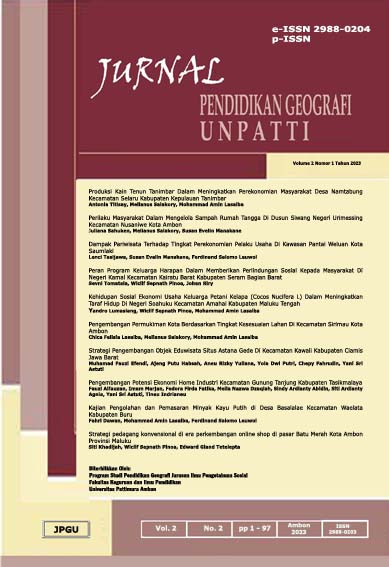Flood Susceptibility Mapping in Ambon City
Pemetaan Kerawanan Banjir di Kota Ambon
Abstract
Flood can be defined as the inundation or flow of water that cannot be contained and exceeds normal limits, resulting in damage to the environment and humans. An area is considered prone to floods if it experiences high rainfall intensity, has low soil capacity or saturated soil, impermeable surfaces, degraded forest conditions, and steep slopes in the upstream area. By using Geographic Information System (GIS), existing data and information can be integrated, and modeling can be easily conducted. Moreover, the tendency of rainfall patterns and the possibility of flooding can be analyzed. Therefore, predictions for flood occurrences and the resulting damages can be promptly determined. Ambon city is an area with a topography that includes flat land, hills, and steep slopes with gradients exceeding 20%. This condition allows the city's development to occupy flat areas, leading to a relatively high population density. On the other hand, limited flat land forces the population to settle on the outskirts of the city, including the slopes of hills and riverbanks.
Downloads
References
Antzoulatos, G., Kouloglou, I. O., Bakratsas, M., Moumtzidou, A., Gialampoukidis, I., Karakostas, A., Lombardo, F., Fiorin, R., Norbiato, D., Ferri, M., Symeonidis, A., Vrochidis, S., & Kompatsiaris, I. (2022). Flood Hazard and Risk Mapping by Applying an Explainable Machine Learning Framework Using Satellite Imagery and GIS Data. Sustainability (Switzerland), 14(6). https://doi.org/10.3390/su14063251
Darmawan, K., Hani’ah, H., & Suprayogi, A. (2017). Analisis Tingkat Kerawanan Banjir Di Kabupaten Sampang Menggunakan Metode Overlay Dengan Scoring Berbasis Sistem Informasi Geografis. Jurnal Geodesi Undip, 6(1), 31–40.
Dewi, N. K. R. R., Nuarsa, I. W., & Adnyana, I. W. S. (2017). Aplikasi Sistem Informasi Geografis (SIG) untuk Kajian Banjir di Kota Denpasar. E-Jurnal Agroekoteknologi Tropika, 6(2), 134–142.
Faisal, Z., Azis, A., Subhan, A. M., Badaruddin, S., & Puspita, D. A. (2020). Spatial Analysis Study on the Flood Impact of WalanaeCenranae River Area in Soppeng Regency South Sulawesi Province. INTEK: Jurnal Penelitian, 7(1), 39. https://doi.org/10.31963/intek.v7i1.2112
Hernoza, F., Susilo, B., & Erlansari, A. (2020). Pemetaan Daerah Rawan Banjir Menggunakan Penginderaan Jauh dengan Metode Normalized Difference Vegetation Index , Normalized Difference Water Index dan Simple Additive Weighting ( Studi Kasus : Kota Bengkulu ). Jurnal Rekursif, 8(2), 144–152. https://ejournal.unib.ac.id/index.php/rekursif/
Kundzewicz, Z. W., Kanae, S., Seneviratne, S. I., Handmer, J., Nicholls, N., Peduzzi, P., Mechler, R., Bouwer, L. M., Arnell, N., Mach, K., Muir-Wood, R., Brakenridge, G. R., Kron, W., Benito, G., Honda, Y., Takahashi, K., & Sherstyukov, B. (2014). Le risque d’inondation et les perspectives de changement climatique mondial et régional. Hydrological Sciences Journal, 59(1), 1–28. https://doi.org/10.1080/02626667.2013.857411
Kwak, Y. (2017). Nationwide Flood Monitoring for Disaster Risk Reduction Using Multiple Satellite Data. https://doi.org/10.3390/ijgi6070203
Lasaiba, M. A. (2006). Evaluasi lahan untuk permukiman dalam pengembangan wilayah Kota Ambon. Tesis. http://etd.repository.ugm.ac.id/penelitian/detail/31752
Lasaiba, M. A. (2013). Kajian Keruangan Penggunaan Lahan Dalam Pengembangan Kota Ambon Berbasis Ekologi. Jurnal Pendidikan Geografi UNESA, 11(21), 34–56.
Lasaiba, M. A. (2016). Dimensi Spasial Karakteristik Sebaran Dan Deviasi Pola Pegunungan Lahan Terhadap Ekosistem Pesisir Di Kota Ambon. Jendela Pengetahuan, 9(1), 24–34.
Lasaiba, M. A. (2022). Fenomena geosfer dalam perspektif geografi telaah substansi dan kompleksitas 1. 15(1), 1–14. https://ojs3.unpatti.ac.id/index.php/jp/article/view/6402/4501
Lestari, R. W., Kanedi, I., & Arliando, Y. (2016). Sistem Informasi Geografis (Sig) Daerah Rawan Banjir Di Kota Bengkulu Menggunakan Arcview. Jurnal Media Infotama, 12(1), 41–48. https://doi.org/10.37676/jmi.v12i1.271
Matondang, J., Kahar, S., & Sasmito, B. (2013). Analisis Zonasi Daerah Rentan Banjir Dengan Pemanfaatan Sistem Informasi Geografis (Studi Kasus : Kota Kendal Dan Sekitarnya). Jurnal Geodesi Undip, 2(2), 84658. https://ejournal3.undip.ac.id/index.php/geodesi/article/view/2442
Muslima, P. L., Lasaiba, M. A., & Salakory, M. (2022). Strategi Peningkatan Pendapatan Pengolah Madu Lebah Hutan ( Apis Dorsata ) Desa Kobisonta Kecamatan Seram Utara Timur Seti Kabupaten Maluku Tengah. 1(1).
Pham, B. T., Phong, T. Van, Nguyen, H. D., Qi, C., Al-Ansari, N., Amini, A., Ho, L. S., Tuyen, T. T., Yen, H. P. H., Ly, H. B., Prakash, I., & Bui, D. T. (2020). A comparative study of kernel logistic regression, radial basis function classifier, multinomial naive bayes, and logistic model tree for flash flood susceptibility mapping. Water (Switzerland), 12(1). https://doi.org/10.3390/w12010239
Plate, E. J. (2002). Flood risk and flood management. Journal of Hydrology, 267(1–2), 2–11. https://doi.org/10.1016/S0022-1694(02)00135-X
Rahman, M., Ningsheng, C., Islam, M. M., Dewan, A., Iqbal, J., Washakh, R. M. A., & Shufeng, T. (2019). Flood Susceptibility Assessment in Bangladesh Using Machine Learning and Multi-criteria Decision Analysis. Earth Systems and Environment, 3(3), 585–601. https://doi.org/10.1007/s41748-019-00123-y
Sofia, G., Roder, G., Dalla Fontana, G., & Tarolli, P. (2017). Flood dynamics in urbanised landscapes: 100 years of climate and humans’ interaction. Scientific Reports, 7(December 2016), 1–12. https://doi.org/10.1038/srep40527
Vojtek, M. (2019). Flood Susceptibility Mapping on a National Scale in Slovakia Using the Analytical Hierarchy Process. https://doi.org/10.3390/w11020364














